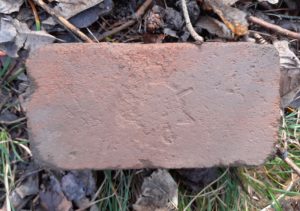Canmore
(Note – SBH – I am unable to pinpoint it on the OS Maps – I will try again!)
Below – 1856 – Canmore suggests Kittleyknowe Tileworks were at the location of the red cross.

11/05/1881 – Greenock Advertiser – Bankruptcy – John Finnie Allan, farmer, Cardrona Mains and Kittleyknowe, Peebleshire. (Were the tileworks on the farm?)
28/05/1881 – Peebleshire Advertiser – The farm of Kittleyknowe formerly farmed by Mr Allan has been rented by Mr James Forrest of Wakefield … (Were the tile works on the farm?)
Below – 05/06/1931 – The Scotsman – Large deposit of silica sand discovered at Kitleyknowes.

07/02/1936 – The Scotsman – New Midlothian industry. An inexhaustible deposit. Arrangements have just been concluded for the working of what is said to be the largest silica sand deposit in Scotland and probably in Britain. There are practically inexhaustible quantities of this sand, suitable for a variety of purposes, including glass-making, at Kitlyknowes, Carlops. After prolonged tests, the sand is reported to be of a kind highly suitable for industrial purposes. The proprietor of the lands in question, which were acquired about seven years ago from the late Mr Graham Yooll, is Mr John Wickham, Deanbank, Gorebridge. For five years Mr Wickham, after getting chemistry specialists to experiment with samples of the sand, became convinced of its possibilities. The late Professor Briggs of the Heriot-Watt College took a keen interest in the deposits and had the silica sand tested in various ways. The results indicated that it was suitable in a high degree for glass working and other industrial purposes. A number of companies who make use of this material became interested in the deposits and a lease of the ground has now been taken for a period of ten years by the General Refractories (Ltd), Genefax House, Sheffield. It is understood that operations for dealing with the silica deposits will be begun within a few weeks. Extensive buildings are to be erected in connection with this new industry for the district, and some 40 to 50 employees will be engaged. The deposits are estimated to be likely to last 100 years, with an output of 24, 000 tons yearly. This great sand deposit will require no sinking or tunnelling. It is exposed to the surface and ready to work.
Below – 10/02/1936 – Aberdeen Press and Journal – John Wickham and his son Mr T. H. Wickham examine the silica deposits. (Note – SBH – Did the silica sand mining ever actually start?)

10/02/1936 – Aberdeen Press and Journal – Scottish silica sand – Big deposit leased by General Refractories. Operations are expected to begin within a few weeks in regard to the working of what is believed to be the largest silica sand deposit in Britain. This is situated in Midlothian at Carlops and a lease of the ground has been taken for a period of ten years by General Refractories. Extensive buildings are to be erected in connection with the establishment of this industry. The sand has been found to be a type highly suitable for industrial purposes and it is estimated that the deposits should last for a hundred years with an output of 24,000 tons yearly. General Refractories manufactures refractory material of every description. The chairman and managing director is Mr Frank S. Russell.
21/02/1936 – The Scotsman – Carlops. Bygone industries – The secluded little Pentland village of Carlops may once more have become a hive of industry. As recently reported in the press, there has been discovered at Kitleyknowe to the Eastward of the village, a large deposit of silica sand, said to be the largest in Scotland, if not Britain. Plant for the treatment of the material will be erected … The silica sand which has now been found would not appear to be a new discovery, for the local doctor, Alexander Pennecuik, wrote in his ‘Description of Tweeddale’ in 1715 – “At Harla Muir there is got an excellent white sand, round and sharp which the mowers of hay take care to wash and beat small and carry many miles, yea the length of Annandale to sharpen their scythes in the season”. Laird Brown writing a hundred years later in 1815 refers to a “bed of freestone on the south bank of the Carlop Burn (At Kitkeyknowe) that crumbles into a fine white powder as white as chalk which is transported many miles for strewing over stone floors and other purposes”. Science has made great progress since 1715 and what was accounted useful for sharpening scythes and sanding stone floors is now, it seems, to be put to a commercial use for a variety of purposes including glass making.
21/02/1936 – Lichfield Mercury – Some years ago Mr John Wickham bought a 250-acre farm at Carlops, Midlothian, for £2,000. Extensive deposits of silica sand have been discovered in the land. This sand, an important ingredient of glass, has a market value of more than £1 per ton. Experts estimate that there is sufficient sand to give a yearly yield of over 24,000 tons for a century.
19/06/1941 – The Scotsman – The death has occurred at Deanbank, Gorebridge; of Mr John Wickham, a well-known Midlothian man. A number of years ago he purchased the farm of KittleyKnowes, Carlops, on which he discovered the presence of silica sand.
Below – 2022 – Could the white areas show the silica sand deposits at Kitleyknowe Farm. This is just south of the Carlop Burn as described in the 21/02/1936 article above.










